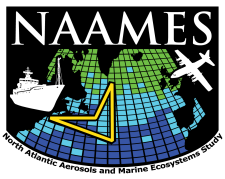The North Atlantic Aerosols and Marine Ecosystems Study (NAAMES) is an interdisciplinary investigation resolving key processes controlling marine ecosystems and aerosols that are essential to our understanding of Earth system function and future change. NAAMES is funded by the NASA Earth Venture Suborbital Program and is the first EV-S mission focused on studying the coupled ocean ecosystem and atmosphere.
Plankton ecosystems of the global ocean profoundly affect climate and life on Earth. NASA's ocean color satellite record tells us that these invaluable ecosystems are highly responsive to climate variability, with changes in ocean production impacting food production, uptake of atmospheric carbon dioxide, and emission of climate-regulating aerosols. Intergovernmental Panel on Climate Change (IPCC) simulations suggest that surface ocean temperatures will warm by +1.3 to +2.8 degrees C globally over the 21st century, with major consequences on physical properties of the surface ocean where plankton populations thrive. The pressing question is, how will these changes alter plankton production, species composition, and aerosol emissions? Today, even the sign of these potential changes remains unresolved. Our ability to predict Earth System consequences of a warming ocean and develop realistic mitigation and adaption strategies depends on resolving conflicting hypotheses regarding the factors controlling plankton ecosystems and biogenic aerosol emissions.
NAAMES consists of four, combined ship and aircraft field campaigns that are each aligned to a specific event in the annual plankton lifecycle. Ship-based measurements provide detailed characterization of plankton stocks, rate processes, and community composition. Ship measurements also characterize sea water volatile organic compounds, their processing by ocean ecosystems, and the concentrations and properties of gases and particles in the overlying atmosphere. These diverse data are extended over broader spatial scales through parallel airborne remote sensing measurements and in situ aerosol sampling that target ocean properties as well as the aerosols and clouds above. The airborne data crucially link local-scale processes and properties to the much larger scale continuous satellite record. Integrating the NAAMES observations with state-of-the-art climate and ecosystems models enables the creation of a process-based foundation for resolving plankton dynamics in other ocean regions, accurately interpreting historical satellite records, and improving predictions of future change and their societal impacts.

